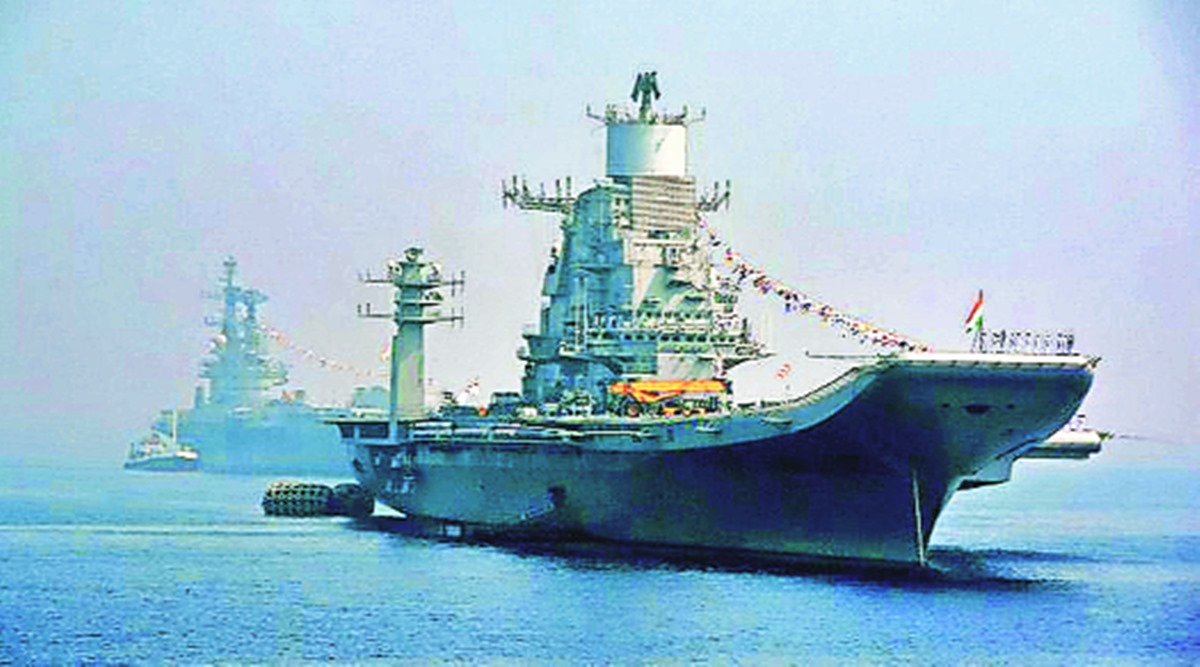[ad_1]
| New Delhi |
December 24, 2020 5:29:12 am
 India currently has one operational aircraft carrier,
India currently has one operational aircraft carrier,
INS Vikramaditya (above), while a second carrier is being constructed at Cochin Shipyard. (File)
A THIRD aircraft carrier is an “operational necessity” for the Navy, a top officer from the force told The Indian Express, days after Navy Chief Admiral Karambir Singh stressed on the importance of aircraft carriers at the Navy Day press conference. The Navy Chief’s views revived the discussion among the forces on whether India needs a third aircraft carrier – apart from INS Vikramaditya and the under-construction Indigenous Aircraft Carrier 1 (IAC 1).
Addressing reporters on December 3, Admiral Singh said the force “does not want to be a Navy tethered to the shore” and “air power at sea is absolutely required”. “The Navy is all about reach and sustenance. If you, as a nation, that is aspirational… you will have to go outwards, seek the world, you will have to move out… And for that you require air power, and you require it at longer ranges, aircraft carrier is absolutely necessary,” he said.
The strong pitch for aircraft carriers, however, may not appear aligned with the views of Chief of Defence Staff General Bipin Rawat, who in the past – and most recently in an interview to India Today last week – said that aircraft carriers are vulnerable targets and that the islands of Andaman and Nicobar and Lakshadweep can be used as “unsinkable aircraft carriers”.
Prioritisation in defence acquisition is one of the major mandates of the Chief of Defence Staff.
The top Navy officer The Indian Express spoke to agreed with Admiral Singh’s views. “If you have to guard your interests, you have to move outwards,” the officer said. “Shouldn’t we have the capability to go where the challenge lies.”
Without mentioning anyone in particular, the officer said, “They say the aircraft carrier will sink if attacked by an anti-ballistic missile… that it can, no doubt as all boats can sink. But then why haven’t we got anti-ballistic missiles? We should also develop them and use them as a deterrent against other forces. If they target our aircraft carriers we should target theirs. Why have this negativity, that an aircraft carrier can sink.”
“We don’t have the luxury,” he said, in terms of finances, “but don’t reject the idea, thinking that it will sink”.
Underlining the importance of defending the vast Indian Ocean Region, the officer stressed on the need for “persistent air power – it should be there, day and night”. “How does America come, how can China come (close to Indian Ocean Region), because they are guarding their interests,” the officer said.
“Three aircraft carriers are tactically needed,” as in the future “surge capability” will be needed, which a third carrier will add, he said.
He said another reason to build and have a third carrier is because of the expertise gained by the Navy and the country to run them. “We are very lucky that we have learned how to operationalise aircraft carriers and naval aviation in 60 years. We have mastered the art of maritime aviation. We have developed the skill over the years, it is not easy to operate an aircraft carrier. Should we let this skill go to waste.”
Giving three major reasons to build and have a third carrier, the officer said that first “it is an operational necessity”, second, “don’t deny yourselves the skill sets in operations, and the skill sets in design and building” of such carriers. Third, he said, “It puts money back into the economy, generates employment and enhances industrial capacity.” He said 90 per cent of the cost will be invested back into the economy as it will be built indigenously, and will boost the economy.
He said, “rather than refining” the capability we have, “it will be pushed off” if the idea is rejected. “It is not that you don’t have the need for another carrier, then you are denying it just for money. That is a misplaced understanding,” the officer said.
Operationally, he said, “When the second carrier is commissioned, the first one will go for refitting, so we will again be left with one. But if you have two, in the field of war, it increases your options by a lot.”
© The Indian Express (P) Ltd
[ad_2]
Source link